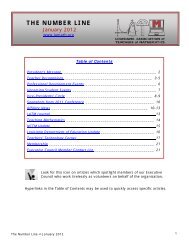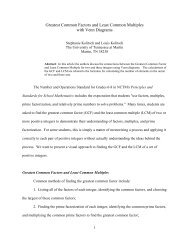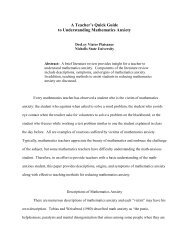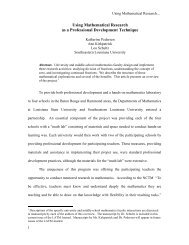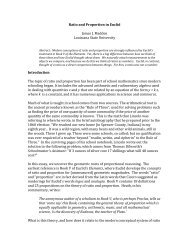Assessment of Students' Learning in Plane & Solid Geometry ...
Assessment of Students' Learning in Plane & Solid Geometry ...
Assessment of Students' Learning in Plane & Solid Geometry ...
Create successful ePaper yourself
Turn your PDF publications into a flip-book with our unique Google optimized e-Paper software.
them for the next stage <strong>of</strong> learn<strong>in</strong>g and that their grades are a reflection <strong>of</strong> the empowerment theyhave and still need.<strong>Assessment</strong> and Grad<strong>in</strong>gThe National Council <strong>of</strong> Teachers <strong>of</strong> Mathematics’ <strong>Assessment</strong> Standards for SchoolMathematics (NCTM 1995) provides guidel<strong>in</strong>es for our facilitation <strong>of</strong> assessment <strong>in</strong> all areas <strong>of</strong>school mathematics, one <strong>of</strong> which is geometry. Accord<strong>in</strong>g to NCTM, “us<strong>in</strong>g multiple sources <strong>of</strong>evidence [assessment techniques] can improve the validity <strong>of</strong> the <strong>in</strong>ferences made about students’learn<strong>in</strong>g. The use <strong>of</strong> multiple sources allows strengths <strong>in</strong> one source to compensate for weaknesses <strong>in</strong>others” (pg. 19). Varied assessment techniques empower the teacher to exam<strong>in</strong>e students’ knowledgeand understand<strong>in</strong>g from different perspectives and at different levels. This position is repeated andfurther supported <strong>in</strong> the NCTM’ Pr<strong>in</strong>ciples and Standards for School Mathematics (NCTM, 2000):“To make effective [<strong>in</strong>struction and curriculum] decisions, teachers should look for convergence <strong>of</strong>evidence from different [assessment] sources. Because different students show what they know andcan do <strong>in</strong> different ways, assessments should allow for multiple approaches, thus giv<strong>in</strong>g a wellroundedpicture and allow<strong>in</strong>g each student to show his or her best strengths. (pg. 23).Topics <strong>in</strong> mathematics lend themselves well to a variety <strong>of</strong> assessment techniques. <strong>Geometry</strong>,the study <strong>of</strong> shapes and relationships between their attributes and solids and the relationships betweentheir attributes, is a topic that engages learners from many different approaches (e.g., hands-on,abstract, pro<strong>of</strong>, visualization). The broadness and depth <strong>of</strong> this mathematical subject make itappropriate and necessary to use multiple sources to assess students’ understand<strong>in</strong>gs <strong>of</strong> the subject.Six sources or techniques <strong>of</strong> assessment that can be used to obta<strong>in</strong> <strong>in</strong>formation about students’geometry learn<strong>in</strong>g are (1) observations, (2) writ<strong>in</strong>g, (3) portfolios, (4) <strong>in</strong>terviews, (5)demonstration/performance tasks, and (6) written tests and quizzes. This is not a complete list, butjust a platform from which a teacher can create assessment plans to determ<strong>in</strong>e how and what studentsare learn<strong>in</strong>g <strong>in</strong> geometry.



